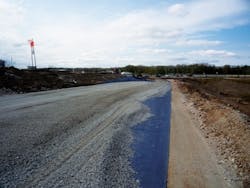Saturated Soil Solution
The Daniel Boone Bridge Design-Build Project began with an investigation by the Missouri Department of Transportation (MoDOT) in the early 2000s. The goal was to replace the westbound span, which was built in 1935 and was never intended to handle modern interstate-level traffic. MoDOT’s studies concluded that the narrow lanes, constant traffic and high maintenance costs necessitated a complete replacement of this span. In 2011, MoDOT allocated $125 million in funding for the project. In 2012, a design-build contract was awarded to the Walsh-Alberici joint venture team with Burns & McDonnell as the design engineer.
Removing the Water
During the initial design phase for the bridge approaches, it became clear that saturated soil conditions would require water to be removed from under the pavement sections. Typical design solutions for this problem would be installing thick, drainable aggregate sections or wick drains, which can add considerable cost to the pavement section. MoDOT encouraged the design-build teams to explore new and innovative technologies to solve the challenging site conditions.
Burns & McDonnell contacted TenCate Geosynthetics to explore the utilization of Mirafi H2Ri high-strength wicking geosynthetic. This technology has a design that not only provides tradtional geosynthetic characteristics to stabilize the roadway, but also has the ability to drain saturated and unsaturated subgrades.
“The numerous geosynthetic research studies and in-field performance from a previous Alaska DOT project really helped sell this solution to MoDOT,” said Mike Lack, manager, alternative pursuits, for Walsh Group.
The objective was to remove water from underneath the pavement section. The design-build team originally designed a pavement section that included a 4-in. layer of drainable aggregate and 4 in. of road base aggregate with a concrete section, all on top of prepared subgrade. The geosynthetic was intended to replace the 4 in. of drainable base, thus providing equivalent capabilities within the section while reducing overall costs. The strength of the geosynthetic, which also provides confinement and separation, allowed for a 2-in. overall reduction in aggregate base material, along with the ability to wick water from under the pavement. The water was able to exit the product through a combination of day lighting the material onto roadway shoulders and into French drains.
“As the prime engineering firm on the Walsh-Alberici design-build team submitting a proposal for the MoDOT Daniel Boone Bridge Project, we were tasked with exploring new and innovative solutions,” said Jeff Mues, St. Louis regional transportation practice leader for Burns & McDonnell. “This included materials not currently included in MoDOT’s standard plans and specifications. Working with TenCate Geosynthetics, we were able to eliminate costly drainable aggregate and underdrains through the inclusion of the wicking geosynthetic. The geosynthetic material also allowed us to eliminate 2 in. of aggregate and maintain the designed pavement life.”
Installation of the Saturated Water Solution
Initial installation of the geosynthetic took place in October 2013 on the north ramp to the westbound approach. TenCate personnel, along with the local distributor, ASP Enterprises, arranged for a preconstruction meeting with the general contractor, MoDOT field personnel and the sub-contractor installing the material. During the meeting and review of the installation procedures, the teams discussed proper overlaps, cutting and layering of the material, and best installation practices
The initial installation required 7,200 sq yd of H2Ri to be installed under 6 in. of compacted aggregate. The day after the geosynthetic was installed, the project site received ¼ in. of rainfall, and wicking was evident where the material terminated at the edge of the road. Saturated soils could be seen extending from the pavement edges and away from the road. An additional 82,000 sq yd of material were installed in the spring and summer of 2014 and continue to perform well.
Repeat Performance
Due to the success of the H2Ri on the Daniel Boone Project, MoDOT has continued to look for opportunities to utilize it in designs where reoccurring moisture problems have proved to be unfixable, including on a troublesome portion of Interstate 70 in St. Charles County, where multiple slab replacement had been constructed over a soft and saturated subgrade.
“It was our opinion that previous repairs with geogrids had failed within six months because of their inability to remove subgrade water,” said Phil Ruffus, senior pavement specialist – St. Louis District for MoDOT.
In May 2016, the failed concrete slabs were removed and a layer of the geosynthetic was installed on the subgrade for reinforcement and lateral drainage prior to placing aggregate and concrete.
“Within 24 hours, the constructed ditch along the shoulder was receiving significant water from the wicking capability of the geosynthetic material,” Ruffus said. “This section of pavement is performing extremely well with no signs of distress.”


